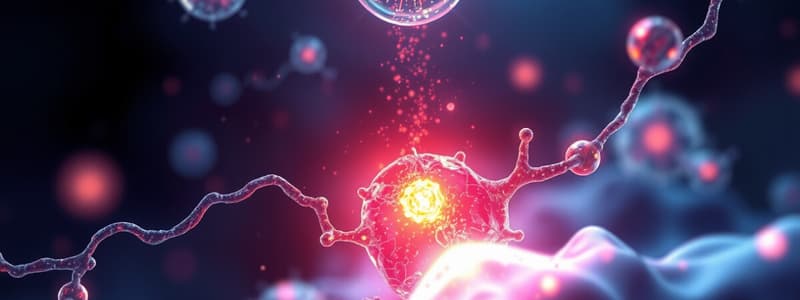Podcast
Questions and Answers
What role does NADPH play in relation to glutathione?
What role does NADPH play in relation to glutathione?
- It is involved in the synthesis of neurotransmitters.
- It converts glutathione into cholesterol.
- It helps maintain glutathione in an active form. (correct)
- It transports glutathione across cellular membranes.
How does NADPH assist in the immune response of phagocytic cells?
How does NADPH assist in the immune response of phagocytic cells?
- By increasing the fragility of red blood cells.
- By forming superoxide from oxygen. (correct)
- By forming lipid peroxides.
- By reducing superoxide to hydrogen peroxide.
What is a consequence of reactive oxygen species (ROS) in red blood cells?
What is a consequence of reactive oxygen species (ROS) in red blood cells?
- Increase in cholesterol synthesis.
- Facilitation of amino acid transport across membranes.
- Lipid peroxidation leading to hemolytic anemia. (correct)
- Enhanced neurotransmitter production.
What is the function of glutathione peroxidase in relation to hydrogen peroxide?
What is the function of glutathione peroxidase in relation to hydrogen peroxide?
What distinguishes G-6-P Dehydrogenase deficiency from drug-induced hemolytic anemia?
What distinguishes G-6-P Dehydrogenase deficiency from drug-induced hemolytic anemia?
Which statement about the metabolism of fructose is correct?
Which statement about the metabolism of fructose is correct?
What enzyme assay would best explain the neurological symptoms of a chronic alcoholic?
What enzyme assay would best explain the neurological symptoms of a chronic alcoholic?
In the liver, fructose is primarily metabolized by which of the following mechanisms?
In the liver, fructose is primarily metabolized by which of the following mechanisms?
Which description of fructose metabolism is incorrect?
Which description of fructose metabolism is incorrect?
What is the primary consequence of a deficiency in transketolase in a chronic alcoholic?
What is the primary consequence of a deficiency in transketolase in a chronic alcoholic?
What sugars are derived from the disaccharide sucrose?
What sugars are derived from the disaccharide sucrose?
Which process allows fructose and galactose to be retained within cells?
Which process allows fructose and galactose to be retained within cells?
What is the primary role of dietary carbohydrates in the body according to new research?
What is the primary role of dietary carbohydrates in the body according to new research?
Which carbohydrate is NOT listed as important in the content provided?
Which carbohydrate is NOT listed as important in the content provided?
What classification accurately describes the importance of certain carbohydrates in the diet?
What classification accurately describes the importance of certain carbohydrates in the diet?
What is the source of galactose in the human diet?
What is the source of galactose in the human diet?
How are fructose 1-P and galactose 1-P metabolized in the body?
How are fructose 1-P and galactose 1-P metabolized in the body?
Which statement about glucose is true according to the content provided?
Which statement about glucose is true according to the content provided?
What is one of the primary outputs of the pentose phosphate pathway?
What is one of the primary outputs of the pentose phosphate pathway?
Which metabolite is utilized by all cells for glycolysis, glycogen synthesis, and the hexose monophosphate shunt pathway?
Which metabolite is utilized by all cells for glycolysis, glycogen synthesis, and the hexose monophosphate shunt pathway?
Which statement about lactose production in the context of lactase deficiency is correct?
Which statement about lactose production in the context of lactase deficiency is correct?
What is the role of UDP-glucose in cellular metabolism?
What is the role of UDP-glucose in cellular metabolism?
What inhibits the first step of the Pentose Phosphate Pathway?
What inhibits the first step of the Pentose Phosphate Pathway?
What is the significance of UDP-glucuronate in metabolic processes?
What is the significance of UDP-glucuronate in metabolic processes?
Which of the following is NOT a substrate for glycosyltransferase reactions?
Which of the following is NOT a substrate for glycosyltransferase reactions?
Which condition allows Phase 1 of the Pentose Phosphate Pathway to run?
Which condition allows Phase 1 of the Pentose Phosphate Pathway to run?
What type of reactions are involved in the pentose phosphate pathway to produce ribose-5-phosphate?
What type of reactions are involved in the pentose phosphate pathway to produce ribose-5-phosphate?
Which enzymes are involved in the transfer of carbon units in the non-oxidative phase?
Which enzymes are involved in the transfer of carbon units in the non-oxidative phase?
Glycolsyltransferase reactions require substrates that are derived from which molecule?
Glycolsyltransferase reactions require substrates that are derived from which molecule?
What does ribulose 5-phosphate convert into when isomerized?
What does ribulose 5-phosphate convert into when isomerized?
Which statement is true regarding the reactions in the non-oxidative phase of the Pentose Phosphate Pathway?
Which statement is true regarding the reactions in the non-oxidative phase of the Pentose Phosphate Pathway?
What is the primary purpose of the Pentose Phosphate Pathway?
What is the primary purpose of the Pentose Phosphate Pathway?
What happens to ribulose 5-phosphate if there is a greater need for glycolysis?
What happens to ribulose 5-phosphate if there is a greater need for glycolysis?
Which factor stimulates the Pentose Phosphate Pathway?
Which factor stimulates the Pentose Phosphate Pathway?
Flashcards are hidden until you start studying
Study Notes
Pentose Phosphate Pathway Overview
- NADPH inhibits the 1st and 3rd steps of the pentose phosphate pathway when levels are sufficient, preventing unnecessary pathway activity.
- Phase 1 reactions require NADP+ availability; when NADPH levels are high, Phase 1 is suppressed, while Phase 2 operates as per metabolic needs.
- Phase 2 is stimulated by low NADPH levels or high NADP+ concentrations.
Non-Oxidative Phase
- Comprises five rearrangement and transfer reactions divided into two parts, with all reactions being freely reversible.
- In Part 1, ribulose 5-phosphate converts to ribose 5-phosphate or xylulose 5-phosphate.
- Part 2 involves carbon unit transfer reactions by transketolase and transaldolase, producing fructose 6-phosphate and glyceraldehyde 3-phosphate.
- Transketolase transfers two-carbon units and requires thiamin pyrophosphate; transaldolase transfers three-carbon units.
Functions of NADPH
- Generated for fatty acid synthesis and reduces oxidants such as hydrogen peroxide via glutathione, protecting cells from oxidative damage.
- NADPH is crucial for synthesizing cholesterol, neurotransmitters, and nucleotides.
- In phagocytic cells, NADPH oxidase utilizes NADPH to generate superoxide for destroying microorganisms.
- Plays a key role in defense against reactive oxygen species (ROS), especially in red blood cells, preventing hemolytic anemia.
Reactive Oxygen Species and Hemolysis
- Glucose-6-phosphate dehydrogenase deficiency affects RBC vitality and is a rare form of drug-induced hemolytic anemia.
- Oxidative stress causes lipid peroxidation, making the RBC membrane fragile, resulting in hemolysis.
Fructose and Galactose Metabolism
- Common dietary sugars, derived from sucrose (fructose-glucose) and lactose (galactose-glucose), are phosphorylated for cellular processing.
- Both fructose 1-P and galactose 1-P are converted to glucose metabolism intermediates post-phosphorylation.
Essential Sugars and Nutritional Importance
- Glucose can be synthesized from other sugars, but dietary intake of mannose, galactose, glucose, fucose, xylose, N-acetyl derivatives improves body functions, deemed conditionally essential.
- Nucleotide sugars like uridine diphosphate (UDP)-glucose are crucial for forming glycosylated compounds and metabolites.
Quiz Questions Overview
- Questions involve identifying pathways and functions related to the pentose phosphate pathway, sugar metabolism, and the implications of dietary intake on lactation and athletic performance.
- Relevant enzymes and metabolic pathways are assessed to understand physiological changes and deficiencies in specific conditions, such as alcoholism and lactase deficiency.
Studying That Suits You
Use AI to generate personalized quizzes and flashcards to suit your learning preferences.




